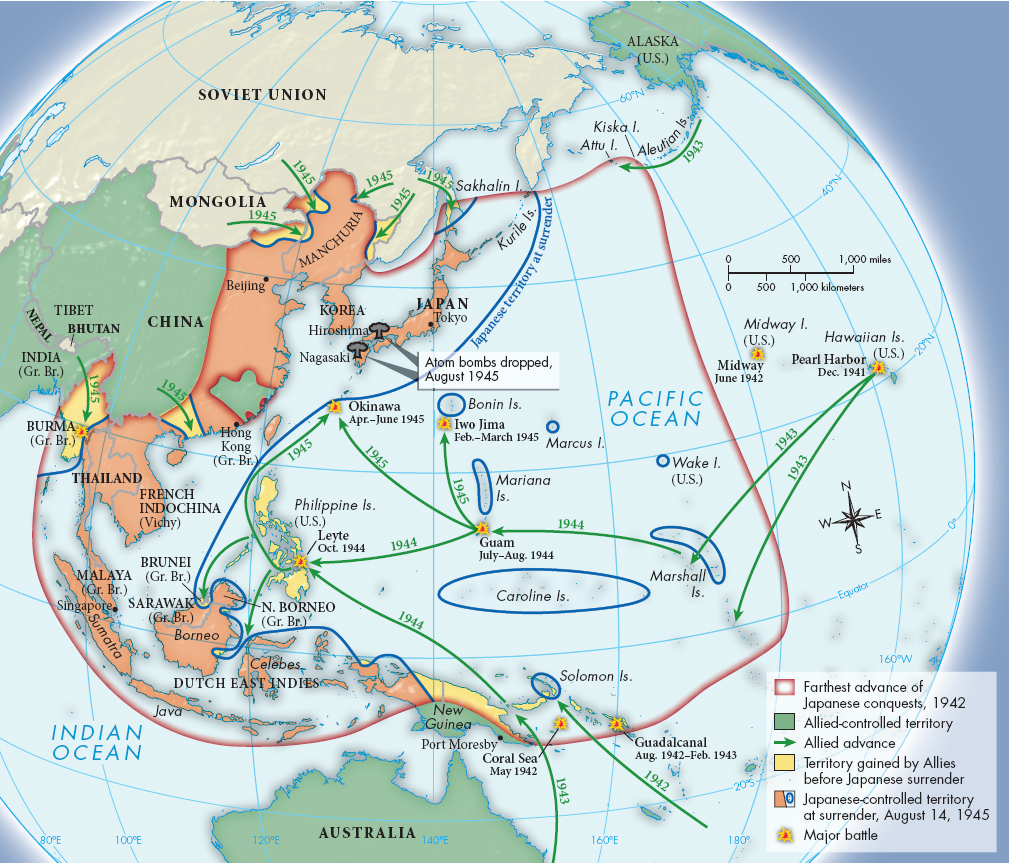Japanese Empire and the War in the Pacific
The racist war of annihilation in Europe was matched by racially inspired warfare in East Asia. In response to political divisions and economic crisis, a Fascist government had taken control of Japan in the 1930s. As in Germany and Italy, the Japanese government was highly nationalistic and militaristic, and it was deeply committed to imperial expansion. According to Japanese race theory, the Asian races were far superior to Western ones. In speeches, schools, and newspapers, ultranationalists eagerly voiced extreme anti-Western views. They glorified the warrior virtues of honor and sacrifice and proclaimed that Japan would liberate East Asia from Western colonialists.
Japan soon acted on its racial-imperial ambitions. In 1931, Japanese armies invaded and occupied Manchuria, a vast territory bordering northeastern China. In 1937, Japan brutally invaded China itself. Seeking to cement ties with the Fascist regimes of Europe, in 1940 the Japanese entered into a formal alliance with Italy and Germany, and in summer 1941, Japanese armies occupied southern portions of the French colony of Indochina (now Vietnam and Cambodia).
The goal was to establish what the Japanese called the Greater East Asia Co-Prosperity Sphere. Under the slogan “Asia for Asians,” Japanese propagandists maintained that this expansion would free Asians from hated Western imperialists. By promising to create a mutually advantageous union for long-term development, the Japanese tapped currents of nationalist sentiment, and most local populations were glad to see the Westerners go.
But the Co-Prosperity Sphere was a sham. Real power remained in the hands of the Japanese. They exhibited great cruelty toward civilian populations and prisoners of war, and exploited local peoples for Japan’s wartime needs. Nonetheless, the ability of the Japanese to defeat the Western colonial powers set a powerful example for national liberation groups in Asia, which would become important in the decolonization movement that followed World War II.
Japanese expansion from 1937 to 1941 evoked a sharp response from U.S. president Franklin Roosevelt, and Japan’s leaders came to believe that war with the United States was inevitable. They decided to launch a surprise attack on the U.S. fleet based at Pearl Harbor in the Hawaiian Islands. On December 7, 1941, the Japanese sank or crippled every American battleship, but by chance all the American aircraft carriers were at sea and escaped unharmed. Pearl Harbor brought the Americans into the war in a spirit of anger and revenge.
As the Americans mobilized for war, Japanese expansion continued. By May 1942, Japan controlled a vast empire (Map 27.5) and was threatening Australia. The Americans pushed back and engaged the Japanese in a series of hard-fought naval battles. In July 1943, the Americans and their Australian allies opened a successful island-hopping campaign that slowly forced Japan out of its conquered territories. The war in the Pacific was extremely brutal and atrocities were committed on both sides. A product of spiraling violence, mutual hatred, and dehumanizing racial stereotypes, the fighting intensified as the United States moved toward Japan.2

MAP 27.5
World War II in the PacificIn 1942, Japanese forces overran an enormous amount of territory, which the Allies slowly recaptured in a long, bitter struggle. As this map shows, Japan still held a large Asian empire in August 1945, when the unprecedented devastation of atomic warfare suddenly forced it to surrender.
